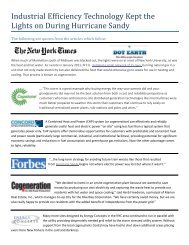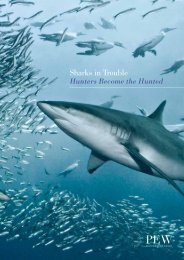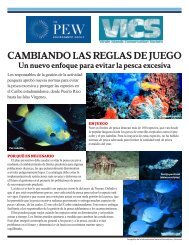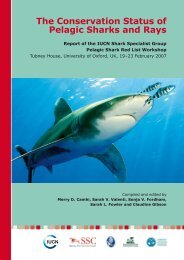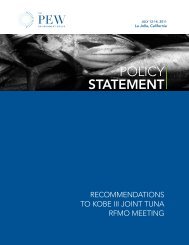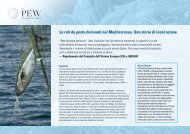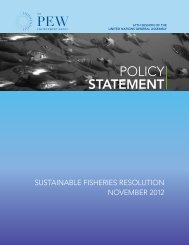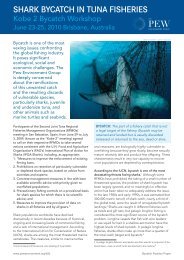The Law That's Saving American Fisheries - Ocean Conservancy
The Law That's Saving American Fisheries - Ocean Conservancy
The Law That's Saving American Fisheries - Ocean Conservancy
Create successful ePaper yourself
Turn your PDF publications into a flip-book with our unique Google optimized e-Paper software.
environment provides. <strong>The</strong>se services include fuel, mineral<br />
resources, pharmaceuticals, flood control, and water cycling as<br />
well as opportunities for recreation, trade, research, and education.<br />
62 <strong>The</strong> challenge for fisheries managers is how to apply<br />
widely accepted principles in practical management decisions.<br />
Scientists, managers, fishermen, and members of Congress<br />
have been talking about ecosystem-based approaches to<br />
fishery management for more than two decades. Congress<br />
requested a report on the topic in 1996, and numerous tools<br />
and approaches are in place. <strong>The</strong> final report to Congress of<br />
the U.S. Commission on <strong>Ocean</strong> Policy noted that the offshore<br />
area of the country’s exclusive economic zone is the largest<br />
in the world. To preserve the resources of this vast territory<br />
for the benefit of all <strong>American</strong>s, the commission called for<br />
fishery managers to begin moving toward an ecosystem-based<br />
approach to look beyond fisheries and consider interactions<br />
with other resources and activities. 63<br />
A task force of scientists, for example, recently described the<br />
major impact of little fish such as herring, anchovies, menhaden,<br />
and sardines and concluded they have twice as much value left<br />
in the water to feed other fish than as target catch themselves,<br />
even though they account for more than one-third of wild<br />
marine fish caught globally. 64 How managers allow for the role<br />
of these forage fish is just one of the remaining frontiers in our<br />
understanding of ocean ecosystems.<br />
Although work remains to rebuild depleted stocks, some<br />
fishery management councils and the scientists who advise<br />
them are asking questions about more than just setting<br />
catch limits. <strong>The</strong>y are considering habitat, socioeconomics,<br />
ecological information, and other factors that go into shaping<br />
our expectations for how we achieve continuing yields from<br />
the waters off our coasts.<br />
<strong>The</strong> councils already have the authority under the Magnuson-<br />
Stevens Act to employ an ecosystem-based approach to<br />
habitats and wildlife. <strong>The</strong> law’s definition of conservation and<br />
management recognizes the importance of protecting marine<br />
ecosystems and avoiding long-term adverse effects on fishery<br />
resources and the marine environment. 65<br />
Specific examples include the authority to reduce fishing<br />
levels to account for ecological factors, 66 and to identify and<br />
protect essential fish habitat. 67 Councils may consider ecological<br />
factors such as component species in the ecosystem,<br />
forage fish stocks, predator-prey dynamics, competitive<br />
interactions, marine mammals and birds, and threatened or<br />
endangered species. 68<br />
Some councils already use identification of essential fish<br />
habitat, stock assessment and fishery evaluation reports, environmental<br />
impact review, and fishery ecosystem plans. Since<br />
1999, the Western Pacific, North Pacific, and South Atlantic<br />
councils have devised ecosystem plans, but there is little guidance<br />
from NOAA <strong>Fisheries</strong> or the law itself on how to develop<br />
these plans or how they relate to regulatory measures. 69<br />
Separately, however, revisions to habitat protection measures<br />
in 2006 strengthened the councils’ authority to address<br />
ecosystem concerns by adding new language on habitats,<br />
authorizing them to protect deep-sea corals and restrict the<br />
use of destructive gear types within known areas of deep-sea<br />
coral habitat. 70 This action meant councils could protect vulnerable<br />
marine habitats and species in their own right as important<br />
components of the marine ecosystem, even without a determination<br />
that they were essential habitat for a fishery. 71<br />
<strong>The</strong>se are important tools, yet councils and managers lack<br />
specific legal mandates to address the broader issues that<br />
affect fish and the environment that marine species depend<br />
on. For instance, there is no requirement to set forage fish<br />
catch limits low enough to accommodate the needs of the<br />
fish and wildlife that need them for food. Nor is there a<br />
requirement to develop fisheries ecosystem plans and ensure<br />
that management measures are consistent with those plans.<br />
Ecosystem-based management will require broader thinking<br />
and possibly changes in law and policy. One step would be<br />
continued development of our science and understanding.<br />
Another would be the application of tools to assess the<br />
health of fish populations. <strong>The</strong>se include risk analysis and<br />
expansion of current stock assessments to incorporate other<br />
key environmental factors, including predator-prey interactions.<br />
<strong>The</strong>se initial actions would enable scientists, managers,<br />
and decision makers to think more broadly about choices.<br />
Fish cluster around a coral cap at Flower<br />
Garden Banks National Marine Sanctuary off<br />
the coast of Texas.<br />
NOAA<br />
36 It’s a Keeper



